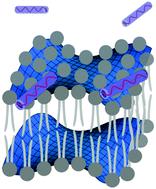当前位置:
X-MOL 学术
›
Soft Matter
›
论文详情
Our official English website, www.x-mol.net, welcomes your
feedback! (Note: you will need to create a separate account there.)
Saddle-curvature instability of lipid bilayer induced by amphipathic peptides: a molecular model.
Soft Matter ( IF 2.9 ) Pub Date : 2020-05-06 , DOI: 10.1039/d0sm00499e Rachel Downing 1 , Guilherme Volpe Bossa 2 , Sylvio May 1
Soft Matter ( IF 2.9 ) Pub Date : 2020-05-06 , DOI: 10.1039/d0sm00499e Rachel Downing 1 , Guilherme Volpe Bossa 2 , Sylvio May 1
Affiliation

|
Amphipathic peptides that partition into lipid bilayers affect the curvature elastic properties of their host. Some of these peptides are able to shift the Gaussian modulus to positive values, thus triggering an instability with respect to the formation of saddle curvatures. To characterize the generic aspects of the underlying mechanism, we employ a molecular lipid model that accounts for the interfacial tension between the polar and apolar regions of the membrane, for interactions between the lipid headgroups, and for the energy to stretch or compress the hydrocarbon chains. Peptides are modeled as cylinders that partition into the host membrane in a parallel orientation where they diminish the space available to the lipid headgroups and chains. The penetration depth into the membrane is determined by the angular size of the peptide's hydrophilic region. We demonstrate that only peptides with a small angular size of their hydrophilic region have an intrinsic tendency to render the Gaussian modulus more positive, and we identify conditions at which the Gaussian modulus adopts a positive sign upon increasing the peptide concentration. Our model allows us to also incorporate electrostatic interactions between cationic peptides and anionic lipids on the level of the linear Debye–Hückel model. We show that electrostatic interactions tend to shift the Gaussian modulus toward more positive values. Steric and electrostatic lipid–peptide interactions jointly decrease the effective interaction strength in the headgroup region of the host membrane thus suggesting a generic mechanisms of how certain amphipathic peptides are able to induce the formation of saddle curvatures.
中文翻译:

两亲性肽诱导的脂质双层的鞍形弯曲不稳定性:分子模型。
分成脂质双层的两亲性肽会影响其宿主的曲率弹性。这些肽中的某些能够将高斯模量移动到正值,从而触发鞍形曲率形成的不稳定性。为了表征潜在机制的一般方面,我们采用分子脂质模型,该模型解释了膜的极性和非极性区域之间的界面张力,脂质头基之间的相互作用以及拉伸或压缩烃链的能量。肽被建模为圆柱体,它们以平行方向分配到宿主膜中,在圆柱体中它们减少了脂类头基和链的可用空间。进入膜的渗透深度取决于肽的角大小 亲水区域。我们证明只有具有较小亲水区域角尺寸的肽才具有使高斯模量更呈正数的内在趋势,并且我们确定了在增加肽浓度时高斯模量采用正号的条件。我们的模型允许我们在线性Debye–Hückel模型的水平上并入阳离子肽和阴离子脂质之间的静电相互作用。我们表明静电相互作用倾向于将高斯模量移向更正的值。立体和脂质脂质静电相互作用共同降低了宿主膜头基区域的有效相互作用强度,因此暗示了某些两亲性肽如何能够诱导鞍形弯曲形成的通用机制。我们证明只有具有较小亲水区域角尺寸的肽才具有使高斯模量更呈正数的内在趋势,并且我们确定了在增加肽浓度时高斯模量采用正号的条件。我们的模型允许我们在线性Debye–Hückel模型的水平上并入阳离子肽和阴离子脂质之间的静电相互作用。我们表明静电相互作用倾向于将高斯模量移向更正的值。立体和脂质脂质静电相互作用共同降低了宿主膜头基区域的有效相互作用强度,因此暗示了某些两亲性肽如何能够诱导鞍形弯曲形成的通用机制。我们证明只有具有较小亲水区域角尺寸的肽才具有使高斯模量更呈正数的内在趋势,并且我们确定了在增加肽浓度时高斯模量采用正号的条件。我们的模型允许我们在线性Debye–Hückel模型的水平上并入阳离子肽和阴离子脂质之间的静电相互作用。我们表明静电相互作用倾向于将高斯模量移向更正的值。立体和静电脂质-肽相互作用共同降低了宿主膜头基区域的有效相互作用强度,因此暗示了某些两亲性肽如何能够诱导鞍形弯曲形成的通用机制。
更新日期:2020-05-06
中文翻译:

两亲性肽诱导的脂质双层的鞍形弯曲不稳定性:分子模型。
分成脂质双层的两亲性肽会影响其宿主的曲率弹性。这些肽中的某些能够将高斯模量移动到正值,从而触发鞍形曲率形成的不稳定性。为了表征潜在机制的一般方面,我们采用分子脂质模型,该模型解释了膜的极性和非极性区域之间的界面张力,脂质头基之间的相互作用以及拉伸或压缩烃链的能量。肽被建模为圆柱体,它们以平行方向分配到宿主膜中,在圆柱体中它们减少了脂类头基和链的可用空间。进入膜的渗透深度取决于肽的角大小 亲水区域。我们证明只有具有较小亲水区域角尺寸的肽才具有使高斯模量更呈正数的内在趋势,并且我们确定了在增加肽浓度时高斯模量采用正号的条件。我们的模型允许我们在线性Debye–Hückel模型的水平上并入阳离子肽和阴离子脂质之间的静电相互作用。我们表明静电相互作用倾向于将高斯模量移向更正的值。立体和脂质脂质静电相互作用共同降低了宿主膜头基区域的有效相互作用强度,因此暗示了某些两亲性肽如何能够诱导鞍形弯曲形成的通用机制。我们证明只有具有较小亲水区域角尺寸的肽才具有使高斯模量更呈正数的内在趋势,并且我们确定了在增加肽浓度时高斯模量采用正号的条件。我们的模型允许我们在线性Debye–Hückel模型的水平上并入阳离子肽和阴离子脂质之间的静电相互作用。我们表明静电相互作用倾向于将高斯模量移向更正的值。立体和脂质脂质静电相互作用共同降低了宿主膜头基区域的有效相互作用强度,因此暗示了某些两亲性肽如何能够诱导鞍形弯曲形成的通用机制。我们证明只有具有较小亲水区域角尺寸的肽才具有使高斯模量更呈正数的内在趋势,并且我们确定了在增加肽浓度时高斯模量采用正号的条件。我们的模型允许我们在线性Debye–Hückel模型的水平上并入阳离子肽和阴离子脂质之间的静电相互作用。我们表明静电相互作用倾向于将高斯模量移向更正的值。立体和静电脂质-肽相互作用共同降低了宿主膜头基区域的有效相互作用强度,因此暗示了某些两亲性肽如何能够诱导鞍形弯曲形成的通用机制。













































 京公网安备 11010802027423号
京公网安备 11010802027423号